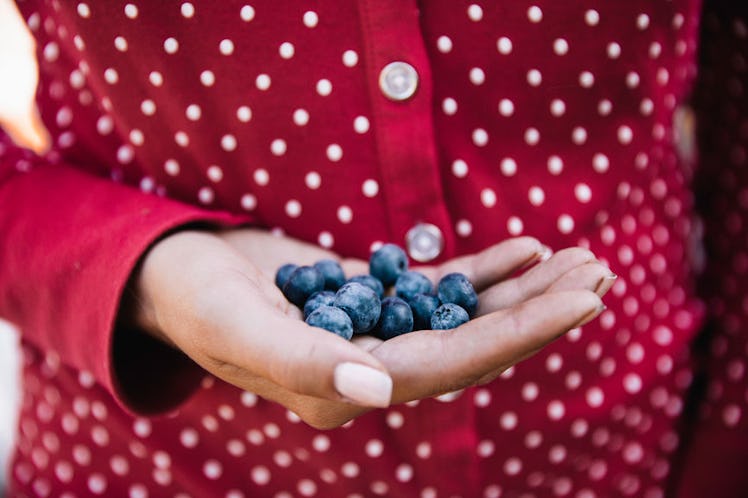
The Benefits Of Blue & Purple Foods Go Way Beyond Instagram Aesthetic, So Eat Up
When I'm cooking specifically for an Instagram photo, I have to admit that I choose my ingredients a little differently. For instance, I tend to pay more attention to the variety of colors and textures in the dish I'm making so that it doesn't just look like a pile of mush on camera. In my opinion, the brighter the colors, the better, because a striking purple potato (yes, it's a thing) is more likely to catch someone's eye than a standard white one. Besides being beautiful to look at, though, the health benefits of blue and purple foods are pretty legit, so you might want to put them on your next grocery list, for both your body's sake and your Insta aesthetic's.
You might not realize it just by looking at their pretty hues, but blue and purple foods are actually really nutritious and can have some pretty solid benefits for your overall health. For example, a new study published in the Journal of Gerontology Series A found that eating 200 grams (aka about two cups) of blueberries per day over the period of a month can lead to significant heart health benefits. After monitoring the blood pressure levels of 40 participants — who were randomly given either a daily blueberry drink, or a daily "matched control drink" over the course of a month, per the study's press release — researchers were able to see that the blueberry intake reduced people's blood pressure, so much so that it was actually comparable to the effects of a typical blood pressure-lowering medication.
"If the changes we saw in blood vessel function after eating blueberries every day could be sustained for a person's whole life," lead researcher Dr. Ana Rodriguez-Mateos said in a statement for the study's press release, "it could reduce their risk of developing cardiovascular disease by up to 20%."
The tiny berry studding your morning muffin isn't just good for your heart, though. According to holistic nutritionist Miriam Amselem, the fruit benefits pretty much your entire body. "Blueberries are the rockstar fruits when it comes to brain health because they are loaded with antioxidants that may delay brain aging and improve memory," she tells Elite Daily in an email.
But blueberries don't have the produce market cornered on heart and brain health. All natural foods in this color family have some major perks. "Blue and purple foods owe their beautiful color to anthocyanin, a type of naturally-occurring pigment called a flavonoid," registered dietitian/nutritionist Kim Yawitz tells Elite Daily. "Flavonoids, and another type of pigments called carotenoids, add color to our diets, and each of these pigments brings different health benefits."
Intrigued? Here are a few to shop for the next time you're in the produce aisle.
Add some dried prunes to your cheese board
Amy Gorin, MS, RDN, owner of Amy Gorin Nutrition in the New York City area and a nutrition partner with Sunsweet, suggests reaching for some tart prunes to get your purple fix. "Prunes boast many antioxidants, including phenolic compounds," she tells Elite Daily in an email. "Prunes contain the minerals potassium and magnesium, as well as vitamin K, and these are all important nutrients for bone health."
If you've never really given prunes a chance, you could toss a couple of pieces of the dried fruit into a hearty, filling salad, spread some sweet prune jam onto your morning toast, or, if you're a fan of a nice, big charcuterie/cheese board, try adding a few dried prunes to balance out your plate.
Cook up some eggplant
The flavonoids in this beautiful purple veggie aren't just pleasing to the eye. Yawitz suggests adding eggplant into your diet for all of the amazing health benefits, too. For example, a study published in the British Journal of Nutrition found that the specific combination of flavanols, anthocyanins, and flavanones makes this unassuming piece of produce great for boosting your memory.
The key to avoiding the notorious mushy texture, in my experience at least, is salting your chopped eggplant pieces and waiting until some of the extra water is drawn out before cooking them up.
Slice up some plums
I personally can't think of a single stone fruit that I don't like, but when it comes to health benefits, it seems like plums take the cake. According to a study published in the Journal of Agricultural and Food Chemistry, plums actually contain double the antioxidant levels of other stone fruits like nectarines and peaches. Basically, if you don't love this bright purple fruit, you're plum silly (sorry, I had to).
You can keep things fresh by adding some chopped pieces of the stuff to cereal or oats, but if you're really feeling adventurous, I recommend this spiced plum pie recipe that's sure to make you fall in love with the tart fruit.
Fill up on some juicy blackberries
"These berries get their color from anthocyanins, which are antioxidant color pigments," says Gorin. "Anthocyanins have been linked with many health benefits, including healthy aging benefits."
While this tart berry is delightful on its own, Gorin suggests jazzing things up with a sprinkle of nutmeg, or adding a handful of berries to a bowl of Greek yogurt for a heartier snack.
Munch on pistachios
"But wait," you might be thinking, "pistachios are green, aren't they?" Well, partly, but according to Gorin, the purple-red hues in pistachios mean these tiny nuts are full of antioxidants. "Yup, there’s a reason pistachios are full of color," she explains. "This nut also provides a trio of protein, fiber, and better-for-you healthy fats to help keep you fuller for longer."
Add a handful of the nuts to a bean salad for some extra crunch, or as a surprisingly fancy ingredient to your typical overnight oats.